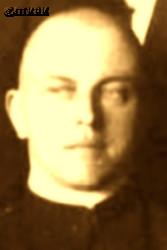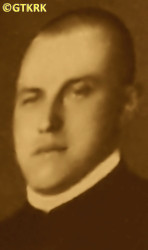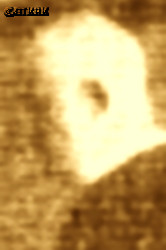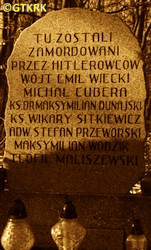Roman Catholic
St Sigismund parish
05-507 Słomczyn
85 Wiślana Str.
Konstancin deanery
Warsaw archdiocese, Poland
full list:
displayClick to display full list

searchClick to search full list by categories
wyświetlKliknij by wyświetlić pełną listę po polsku

szukajKliknij by przeszukać listę wg kategorii po polsku

Martyrology of the clergy — Poland
XX century (1914 – 1989)
personal data
surname
DUNAJSKI
forename(s)
Maximilian (pl. Maksymilian)
forename(s)
versions/aliases
Francis Maximilian (pl. Franciszek Maksymilian)
function
diocesan priest
creed
Latin (Roman Catholic) Church RCmore on
en.wikipedia.org
[access: 2014.09.21]
diocese / province
Culm (Chełmno) diocesemore on
pl.wikipedia.org
[access: 2012.11.23]
RC Military Ordinariate of Polandmore on
en.wikipedia.org
[access: 2014.12.20]
academic distinctions
Doctor of Canon Law
honorary titles
„Medal of Independence”more on
en.wikipedia.org
[access: 2019.02.02]
(22.04.1938)
date and place
of death
22.10.1939

Mestwinowo foresttoday: n. Czarnocin village, Skarszewy gm., Starogard Gdański pov., Pomerania voiv., Poland
more on
en.wikipedia.org
[access: 2025.11.05]
alt. dates and places
of death
09.1939, 20.10.1939, 25.10.1939, 28.10.1939, 11.11.1939
Probostwotoday: part of Więckowy village, Skarszewy gm., Starogard Gdański pov., Pomerania voiv., Poland
more on
en.wikipedia.org
[access: 2022.01.28]
Skarszewytoday: Skarszewy gm., Starogard Gdański pov., Pomerania voiv., Poland
more on
en.wikipedia.org
[access: 2021.07.29]
Jaroszewytoday: Skarszewy gm., Starogard Gdański pov., Pomerania voiv., Poland
more on
en.wikipedia.org
[access: 2021.10.09]
details of death
Till c. 1914 — during German occupation (Prussian partition of Poland) — while studying at the Germ. Königliches Katholisches Gymnasium (Eng. Royal Catholic Gymnasium) in Chełmno, member of the school chapter of the Polish clandestine student self–education Pomeranian Philomaths organization, i.e. Thomas Zan Society.
During I World war drafted into German Imperial Army. Served on the eastern front, in Ukraine.
16.04.1930, by order of the President of the Republic of Poland, appointed reserve chaplain of the Polish Army, with seniority from 01.03.1930 and 1st place among the military Roman Catholic clergy, in the rank of captain (for a statutory period of 2 years).
After German invasion of Poland on 01.09.1939 (Russians invaded Poland 17 days later) and start of the World War II, prob. managed to hide some of the valuables, including those of historical significance, from his.
St Michael the Archangel parish church in Skarszewy.
However, on 08/09.09.1939 — Germans occupation of Skarszewy started on 02.09.1939 — arrested by the Germans, together with his vicar, Fr Bronislav Sitkiewicz.
Held in a temporary detention center in Skarszewy, prob. set up in the parish church.
Every day transported to slave labor in Tczew, c. 20 km away.
Murdered in the Mestwinowo Forest, c. 5 km from Skarszewy and 1.5 km from the village of Czarnocin, near the forester's lodge called Mestwinowo, prob. in a mass murder — part of the Germ. «Intelligenzaktion» (Eng. Operation Intelligentsia) plan to exterminate the Polish intelligentsia and leadership — in which Fr Bronislav Sitkiewicz and five prominent Polish social activists from Skarszewy were also murdered.
The arrests and murders were carried out by members of the genocidal German organization Germ. Volksdeutscher Selbstschutz (Eng. Ethnic German Self‐Defense), i.e. representatives of the German minority in Poland, supported by a special, genocidal SS‐Einsatzkommando 16 (Eng. SS Operational Group No. 16), i.e. EK 16, unit organized by the German state, or more precisely by the Germ. Reichssicherheitshauptamt (Eng. Reich Main Security Office), i.e. RSHA, as well as the German police. The murder site may have been secured by soldiers of the Germ. Wehrmacht (Eng. Armed Forces).
In the forests around Skarszewy (including the Mestwinowo Forest), between 10‐11.1939, the Germans murdered at least 400 inhabitants of Skarszewy and the surrounding area in mass executions. In the winter of 1944, as the triumphant Russians approached Pomerania, the Germans dug up and burned the bodies buried in some of the mass graves. However, after the end of military conflict of the II World War, c. 340 bodies of victims of German terror were exhumed there. His body may have been among them, as some sources state he was buried in Skarszewy.
alt. details of death
According to some sources murdered in a mass execution of Poles in a forests in Skarszewy vicinity, e.g. by a village of Jaroszewy, Probostwo village.
cause of death
mass murder
perpetrators
Germans
sites and events
JaroszewyClick to display the description, «Intelligenzaktion»Click to display the description, Reichsgau Danzig‐WestpreußenClick to display the description, Ribbentrop‐MolotovClick to display the description, Pius XI's encyclicalsClick to display the description, Thomas Zan SocietiesClick to display the description, Pomeranian PhilomathsClick to display the description
date and place
of birth
09.04.1896Birth certification on:
metryki.genbaza.pl
[access: 2025.11.05]

Pogódkitoday: Skarszewy gm., Starogard Gdański pov., Pomerania voiv., Poland
more on
en.wikipedia.org
[access: 2021.09.02]
parents
DUNAJSKI John
🞲 ?, ? — 🕆 ?, ?

BŁAŻEK Domicella
🞲 ?, ? — 🕆 ?, ?
presbyter (holy orders)
ordination
17.06.1923

Pelplintoday: Pelplin gm., Tczew pov., Pomerania voiv., Poland
more on
en.wikipedia.org
[access: 2021.05.06]
St Barbara RC chapelmore on
pl.wikipedia.org
[access: 2021.12.19] (in Theological Seminary)
positions held
1938 – 1939
parish priest — Skarszewytoday: Skarszewy gm., Starogard Gdański pov., Pomerania voiv., Poland
more on
en.wikipedia.org
[access: 2021.07.29] ⋄ St Michael the Archangel RC parish ⋄ Starogard Gdańskitoday: Starogard Gdański gm., Starogard Gdański pov., Pomerania voiv., Poland
more on
en.wikipedia.org
[access: 2021.06.07] RC deanery
1927 – 1937
prefect — Świecietoday: Świecie gm., Świecie pov., Kuyavia‐Pomerania voiv., Poland
more on
en.wikipedia.org
[access: 2021.09.02] ⋄ teacher of religion, Polish and German languages, State Gymnasium ⋄ St Andrew Bobola RC parish ⋄ Świecietoday: Świecie gm., Świecie pov., Kuyavia‐Pomerania voiv., Poland
more on
en.wikipedia.org
[access: 2021.09.02] RC deanery — also: prefekt of „Gregorianum” Bishop's Dormitory; supervisor of students from 13.01.1931 publishing the monthly „Gregorianum”
1927
vicar — Starogard Gdańskitoday: Starogard Gdański gm., Starogard Gdański pov., Pomerania voiv., Poland
more on
en.wikipedia.org
[access: 2021.06.07] ⋄ St Matthew the Apostle RC parish ⋄ Starogard Gdańskitoday: Starogard Gdański gm., Starogard Gdański pov., Pomerania voiv., Poland
more on
en.wikipedia.org
[access: 2021.06.07] RC deanery
1926 – 1927
vicar — Kościerzynatoday: Kościerzyna urban gm., Kościerzyna pov., Pomerania voiv., Poland
more on
en.wikipedia.org
[access: 2021.08.20] ⋄ Holy Trinity RC parish ⋄ Mirachowotoday: Kartuzy gm., Kartuzy pov., Pomerania voiv., Poland
more on
en.wikipedia.org
[access: 2020.11.27] RC deanery
1923 – 1926
PhD student — Rometoday: Rome prov., Lazio reg., Italy
more on
en.wikipedia.org
[access: 2021.12.18] ⋄ canon law — resident: Polish Pontifical College (Lat. Pontificium Collegium Polonorum); PhD thesis Lat. „De legislatione circa synodum dioecesanam” (Eng. „On the legislation concerning the diocesan synod”), public defense in 1926
1919 – 1923
student — Pelplintoday: Pelplin gm., Tczew pov., Pomerania voiv., Poland
more on
en.wikipedia.org
[access: 2021.05.06] ⋄ philosophy and theology, Theological Seminary
1918 – 1939
membership — Toruńtoday: Toruń city pov., Kuyavia‐Pomerania voiv., Poland
more on
en.wikipedia.org
[access: 2021.06.20] ⋄ scientific society
1914 – 1918
soldier — German Imperial Army
till 1914
pupil — Chełmnotoday: Chełmno urban gm., Chełmno pov., Kuyavia‐Pomerania voiv., Poland
more on
en.wikipedia.org
[access: 2021.07.25] ⋄ Germ. Königliche Katholische Gymnasium (Eng. Royal Catholic Gymnasium) — studies completed in 08.1914 with the maturity diploma (i.e. matura)
1907 – 1911
pupil — Pelplintoday: Pelplin gm., Tczew pov., Pomerania voiv., Poland
more on
en.wikipedia.org
[access: 2021.05.06] ⋄ „Collegium Marianum” progymnasium
Catholic journalist
others related
in death
KAJUTClick to display biography John, KINKAClick to display biography Valerian, KŁOSClick to display biography Anthony, MAŁACHOWSKIClick to display biography Paul, RESZKAClick to display biography Boniface, RUCHNIEWICZClick to display biography Hugh Joseph, SITKIEWICZClick to display biography Bronislav, SZUCAClick to display biography Bruno Paul, WĘGIELEWSKIClick to display biography Anthony Francis
sites and events
descriptions
Jaroszewy: In the forests n. Jaroszewy (today: Starogard Gdański county) in 09.1939 Germans — prob. Einsatzkommando EK 16 unit — murdered c. 40 men from Jaroszewy region — as a part of «Intelligenzaktion» directed against Polish leading activists in occupied territories. In 10.1939 further 13 Poles were murdered there. (more on: pl.wikipedia.orgClick to attempt to display webpage
[access: 2019.11.11])
«Intelligenzaktion»: German: «Intelligenzaktion» (English: „Intelligence Action”) — a German program of extermination of the Polish elite, mainly the intelligentsia and leadership layers, carried out from the beginning of the occupation in w 09.1939 to 04.1940, mainly in territories directly annexed to Germany, but also in the so‐called Germ. Generalgouvernement (Eng. General Governorate), where it was called «AB‐aktion». In the first phase, immediately after the beginning of the German occupation, during military operations carried out by the Germ. Wehrmacht (Eng. Armed Forces) and the genocidal units of the Germ. Einsatzgruppen (Eng. Operational Groups) of the Germ. Sicherheitspolizei (Eng. Security Police), i.e. SiPo, and Germ. Sicherheitsdienst des Reichsführers SS (Eng. Security Service of the Reichsführer SS), i.e. SD, organized by the Germ. Reichssicherheitshauptamt (Eng. Reich Main Security Office), i.e. RSHA, which followed the troops, carried out under the Germ. Unternehmen „Tannenberg” (Eng. Operation „Tannenberg”) — based on the so‐called Germ. Sonderfahndungsliste (Eng. Special Wanted Lists), i.e. proscription lists of Poles considered particularly dangerous to the Third Reich, prepared by the Zentralstelle II/P (Polen) unit of the German RSHA. Later, implemented by the German civilian occupation authorities and the genocidal unit of the Germ. Volksdeutscher Selbstschutz (Eng. Ethnic Germans Self‐Defense), whose members were Germ. Volksdeutsche (Eng. Ethnic Germans), i.e. representatives of the German minority in Poland. According to various sources, these lists, at the beginning of 09.1939, could have contained the details of 61,000—88,000 „dangerous” Poles — although these figures cannot be confirmed. In total, during this genocide, c. 50,000 teachers, Catholic priests, representatives of the landed gentry, freelancers, social and political activists, and retired military personnel were systematically and methodically murdered. Another 50,000 were sent to concentration camps, where only a negligible percentage survived. (more on: en.wikipedia.orgClick to attempt to display webpage
[access: 2014.10.04])
Reichsgau Danzig‐Westpreußen: After the Polish defeat in the 09.1939 campaign, which was the result of the Ribbentrop‐Molotov Pact and constituted the first stage of World War II, and the beginning of German occupation in part of Poland (in the other, eastern part of Poland, the Russian occupation began), the Germans divided the occupied Polish territory into five main regions (and a few smaller). The largest one was transformed into Germ. Generalgouvernement (Eng. General Governorate), intended exclusively for Poles and Jews and constituting part of the so‐called Germ. Großdeutschland (Eng. Greater Germany). Two were added to existing German provinces. From two other separate new provinces were created. Vistula Pomerania region was one of them, incorporated into Germany on 08.10.1939, by decree of the German leader Adolf Hitler (formally came into force on 26.10.1939), and on 02.11.1939 transformed into the Germ. Reichsgau Danzig‐Westpreußen (Eng. Reich District of Gdańsk‐West Prussia) province, in which the law of the German state was to apply. The main axis of the policy of the new province, the territory of which the Germans recognized as the Germ. „Ursprünglich Deutsche” (Eng. „natively German”), despite the fact that 85% of its inhabitants were Poles, was Germ. „Entpolonisierung” (Eng. „Depolonisation”), i.e. forced Germanization. C. 60,000 Poles were murdered in 1939‐1940, as part of the Germ. „Intelligenzaktion”, i.e. extermination of Polish intelligentsia and ruling classes, in c. 432 places of mass executions — including c. 220 Polish Catholic priests. The same number were sent to German concentration camps, from where few returned (over 300 priests were arrested, of whom c. 130 died in concentration camps). C. 124,000‐170,000 were displaced, including c. 90,000 to the Germ. Generalgouvernement. Poles were forced en masse to sign the German nationality list, the Germ. Deutsche Volksliste DVL. Polish children could only learn in German. It was forbidden to use the Polish language during Catholic Holy Masses and during confession. Polish landed estates were confiscated..To further reduce the number of the Polish population, Poles were sent to forced labor deep inside Germany. The remaining Poles were treated as low‐skilled labor, isolated from the Germans and strictly controlled — legally, three or three of them could only meet together, even in their own apartments. Many were conscripted into the German Wehrmacht army. After the end of hostilities of World War II, the overseer of this province, the Germ. Reichsstatthalter (Eng. Reich Governor) and the Germ. Gauleiter (Eng. district head) of the German National Socialist Party, Albert Maria Forster, was executed. (more on: en.wikipedia.orgClick to attempt to display webpage
[access: 2024.06.24])
Ribbentrop‐Molotov: Genocidal Russian‐German alliance pact between Russian leader Joseph Stalin and German leader Adolf Hitler signed on 23.08.1939 in Moscow by respective foreign ministers, Mr. Vyacheslav Molotov for Russia and Joachim von Ribbentrop for Germany. The pact sanctioned and was the direct cause of joint Russian and German invasion of Poland and the outbreak of the World War II in 09.1939. In a political sense, the pact was an attempt to restore the status quo ante before 1914, with one exception, namely the „commercial” exchange of the so‐called „Kingdom of Poland”, which in 1914 was part of the Russian Empire, fore Eastern Galicia (today's western Ukraine), in 1914 belonging to the Austro‐Hungarian Empire. Galicia, including Lviv, was to be taken over by the Russians, the „Kingdom of Poland” — under the name of the General Governorate — Germany. The resultant „war was one of the greatest calamities and dramas of humanity in history, for two atheistic and anti‐Christian ideologies — national and international socialism — rejected God and His fifth Decalogue commandment: Thou shall not kill!” (Abp Stanislav Gądecki, 01.09.2019). The decisions taken — backed up by the betrayal of the formal allies of Poland, France and Germany, which on 12.09.1939, at a joint conference in Abbeville, decided not to provide aid to attacked Poland and not to take military action against Germany (a clear breach of treaty obligations with Poland) — were on 28.09.1939 slightly altered and made more precise when a treaty on „German‐Russian boundaries and friendship” was agreed by the same murderous signatories. One of its findings was establishment of spheres of influence in Central and Eastern Europe and in consequence IV partition of Poland. In one of its secret annexes agreed, that: „the Signatories will not tolerate on its respective territories any Polish propaganda that affects the territory of the other Side. On their respective territories they will suppress all such propaganda and inform each other of the measures taken to accomplish it”. The agreements resulted in a series of meeting between two genocidal organization representing both sides — German Gestapo and Russian NKVD when coordination of efforts to exterminate Polish intelligentsia and Polish leading classes (in Germany called «Intelligenzaktion», in Russia took the form of Katyń massacres) where discussed. Resulted in deaths of hundreds of thousands of Polish intelligentsia, including thousands of priests presented here, and tens of millions of ordinary people,. The results of this Russian‐German pact lasted till 1989 and are still in evidence even today. (more on: en.wikipedia.orgClick to attempt to display webpage
[access: 2015.09.30])
Pius XI's encyclicals: Facing the creation of two totalitarian systems in Europe, which seemed to compete with each other, though there were more similarities than contradictions between them, Pope Pius XI issued in 03.1937 (within 5 days) two encyclicals. In the „Mit brennender Sorge” (Eng. „With Burning Concern”) published on 14.03.1938, condemned the national socialism prevailing in Germany. The Pope wrote: „Whoever, following the old Germanic‐pre‐Christian beliefs, puts various impersonal fate in the place of a personal God, denies the wisdom of God and Providence […], whoever exalts earthly values: race or nation, or state, or state system, representatives of state power or other fundamental values of human society, […] and makes them the highest standard of all values, including religious ones, and idolizes them, this one […] is far from true faith in God and from a worldview corresponding to such faith”. On 19.03.1937, published „Divini Redemptoris” (Eng. „Divine Redeemer”), in which criticized Russian communism, dialectical materialism and the class struggle theory. The Pope wrote: „Communism deprives man of freedom, and therefore the spiritual basis of all life norms. It deprives the human person of all his dignity and any moral support with which he could resist the onslaught of blind passions […] This is the new gospel that Bolshevik and godless communism preaches as a message of salvation and redemption of humanity”… Pius XI demanded that the established human law be subjected to the natural law of God , recommended the implementation of the ideal of a Christian state and society, and called on Catholics to resist. Two years later, National Socialist Germany and Communist Russia came together and started World War II. (more on: www.vatican.vaClick to attempt to display webpage
[access: 2023.05.28], www.vatican.vaClick to attempt to display webpage
[access: 2023.05.28])
Thomas Zan Societies: Secret societies of Polish youth, aiming at self‐education, patriotic in form and content, functioning 1830‐1920, in mutiny against enforced Germanisation and censure of Polish culture, mainly in secondary schools — gymnasia — mainly in Greater Poland (Wielkopolska) and later in Silesia. The first groups were formed in 1817. In 1897 a congress in Bydgoszcz was held when rules of clandestine activities were formulated. At other congress in Bydgoszcz in Poznań a „Red Rose” society was formed, heading all others groups in various gymnasiums and coordinating their activities. In 1900 „Red Rose” consolidated Philomaths organizations from Pomerania as well. After Toruń trial of Pomeranian Philomaths in Toruń Germans arrested 24 members of Thomas Zan Society from Gniezno. 21 of them were sentenced up to 6 weeks in prison and reprimands. All were relegated from schools without the right to continue education in secondary and higher schools in Prussia. Despite repression the Societies existed till 1918 and rebirth of Poland. (more on: pl.wikipedia.orgClick to attempt to display webpage
[access: 2021.12.19])
Pomeranian Philomaths: Secret societies of Polish youth, aiming at self‐education, patriotic in form and content, functioning 1830‐1920, mainly in secondary schools — gymnasia — in Pomerania around Vistula river (Gdańsk Pomerania and Chełmno county), in Prussian‐occupied Polish territories (one of the partitions of Poland). On 08.01.1901 Germans conducted a series of interrogations of students at Chełmno, Brodnica and Toruń gymnasiums. On 09‐12.09.1901 the first of court trials of Polish students from those gymnasiums and students of Theological Seminary in Pelplin was held in Toruń. 1 person was sentenced to 3 months in prison, 1 to 2 months, 3 to 6 weeks, 7 to 3 weeks, 2 to 2 weeks, 19 to a week, 2 to 1 day, 10 were reprimanded. 15 were cleared. More definitive penalties were relegations from the schools with so‐called wolf’s ticket, forbidding sentenced students to continue secondary and higher studies in Prussia (Germany). Among those penalized were a few future Catholic priests — those were able to continue their education for the Chełmno diocese bishop, Bp August Rosentreter, refused to relegate students from Theological Seminary. (more on: pl.wikipedia.orgClick to attempt to display webpage
[access: 2018.11.18])
sources
personal:
tczew.naszemiasto.plClick to attempt to display webpage
[access: 2013.08.17], www.sgw.com.plClick to attempt to display webpage
[access: 2015.09.30], tczew.naszemiasto.plClick to attempt to display webpage
[access: 2018.03.25], metryki.genbaza.plClick to attempt to display webpage
[access: 2025.11.05], www.kpbc.ukw.edu.plClick to attempt to display webpage
[access: 2014.10.04]
bibliographical:
„Biographical dictionary of priests ordained in the years 1921‐1945 working in the Chełmno diocese”, Fr Anastasius Nadolny, prof., Bernardinum publishing house 2021
original images:
bazhum.muzhp.plClick to attempt to display webpage
[access: 2018.09.23], bazhum.muzhp.plClick to attempt to display webpage
[access: 2018.09.23], kociewie24.euClick to attempt to display webpage
[access: 2025.11.05]
LETTER to CUSTODIAN/ADMINISTRATOR
If you have an Email client on your communicator/computer — such as Mozilla Thunderbird, Windows Mail or Microsoft Outlook, described at WikipediaPatrz:
en.wikipedia.org, among others — try the link below, please:
LETTER to CUSTODIAN/ADMINISTRATORClick and try to call your own Email client
If however you do not run such a client or the above link is not active please send an email to the Custodian/Administrator using your account — in your customary email/correspondence engine — at the following address:

giving the following as the subject:
MARTYROLOGY: DUNAJSKI Maximilian
To return to the biography press below:
 Click to return to biography
Click to return to biography












